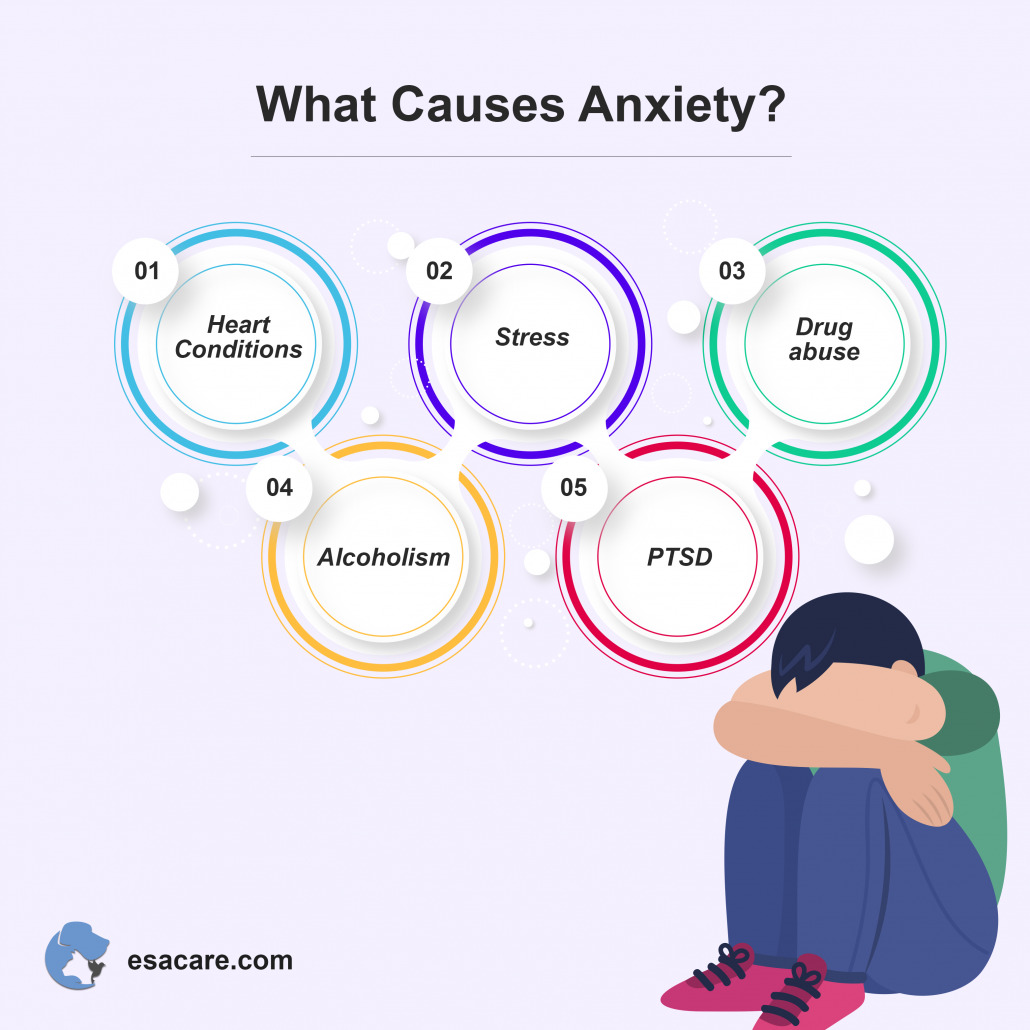How Can an Emotional Support Animal Help My Anxiety?
Emotional Support Animal for Anxiety
Anxiety disorders are the most common mental health concern in the United States, with an estimated 18% of the population undergoing treatment. Although it is perfectly natural to feel some level of anxiety or worry from time to time, when it becomes so overwhelming that it is disabling and prevents you from living a normal life, you may be suffering from an anxiety disorder.
Carry an authentic ESA letter to travel with your pet – Click the button below.
Several conditions are classified as anxiety disorders, and for some individuals, dealing with more than one is not uncommon. Most doctors group the various diseases into five different classifications; generalized anxiety, panic disorder, social anxiety, specific phobias, and PTSD (post-traumatic stress disorder). Depending on which specific disorder or the combination, will determine how anxiety will affect the patient.
However, all share some of the same general symptoms:
- Panic, fear, or uneasiness
- Issues sleeping
- Inability to stay calm and still
- Cold, sweaty, numb, or tingling hands or feet
- Shortness of breath
- Heart palpitations
- Dry mouth
- Nausea
- Tense muscles
- Dizziness
What is an Emotional Support Animal?
Although many people are familiar with service dogs for the blind or deaf, they may not have heard of an emotional support animal (ESA). ESAs are companion animals that are prescribed by a licensed mental health practitioner (LMHP) to help patients deal with the symptoms associated with a mental or emotional condition such as an anxiety disorder. Unlike service dogs, ESAs are not trained to perform any specific task or job; their main function is to offer unconditional love and companionship to the patient. For many, the animal’s presence helps them to focus on something other than the situation around them and allows them to work through any emotional stress or discomfort.

ESA
Working with an ESA
Patients who have been diagnosed with an anxiety disorder may find that when an emotional support animal is brought into the treatment regimen, they become more focused on the care and comfort of the animal and think less about the triggering event.
Often, patients who suffer from these disorders feel alone or dejected, even when standing in a room full of people. This feeling can lead to panic attacks and or other more serious conditions such as agoraphobia, though the condition is relatively rare with less than 1% of the population diagnosed as such.
During treatment, patients are often given antidepressants or anti-anxiety medications to help regulate chemicals in the brain that are believed to be responsible for fear and stress. Mental health practitioners also recommend an either group or individualized therapy that encourages patients to talk about their stressors and discover why they feel the way they do. Both medication and therapy are excellent tools to use during treatment. But for some patients, that is not enough.
Studies have shown that patients dealing with stressful situations had physical and chemical changes in their bodies when they are in the presence of animals, especially when they have physical contact. Not only does the patient’s blood pressure lower, but increased heart rates have subsided, and powerful endorphins are released in the brain.
In short, animals can be a powerful yet healthy distraction that prevents patients from feeling the lows associated with anxiety disorders and helps to prevent panic attacks. Read more about ESACare Care and why to choose us.
How to get an ESA?
Because emotional support animals are not the same as service dogs, protections for their use are somewhat limited. However, the federal government recognized them as an important part of the treatment and recovery process for some mental health conditions and as such have added protections for ESAs in certain situations; travel and housing.
Under the Air Carrier Access Act and Fair Housing Act, patients can travel by air and live with their support animal despite regulations that prohibit pets. In order to be protected, patients must be under the care of an LMHP and submit an emotional support animal letter to the airline, landlord, or rental agent for approval.

Causes of anxiety
What is an ESA Letter?
An ESA letter is supplied by the licensed mental health practitioner that is responsible for a patient’s treatment. It offers proof of a qualifying diagnosis and that the support animal is needed for a specific reason related to the disorder. Despite several online claims, the only way to get a valid ESA letter is from the LMHP that is treating the patient. Advertisements for instant or immediate approvals are scams, and though they supply a letter, they are easily debunked by airlines and landlords during their validation process.
Get Your ESA certification by clicking the button below.
Conclusion
Emotional support animals help patients diagnosed with an anxiety disorder. The relationship between humans and their animals tends to strengthen during highly emotional or stressful times. Using this knowledge to your benefit can result in improvements in the way you deal with stressors and can eventually help you to overcome even the harshest of symptoms. Get Your ESA Letter now!
Get your Emotional Support Animal Letter today by booking an appointment at ESACare.










 347 5th Ave Suite 1402-112,
347 5th Ave Suite 1402-112,

Leave a Reply
Want to join the discussion?Feel free to contribute!